A molecular clutch between the actin flow and N-cadherin adhesions drives growth cone migration
- PMID: 18524892
- PMCID: PMC6670336
- DOI: 10.1523/JNEUROSCI.5331-07.2008
A molecular clutch between the actin flow and N-cadherin adhesions drives growth cone migration
Abstract
The adhesion molecule N-cadherin plays important roles in the development of the nervous system, in particular by stimulating axon outgrowth, but the molecular mechanisms underlying this effect are mostly unknown. One possibility, the so-called "molecular clutch" model, could involve a direct mechanical linkage between N-cadherin adhesion at the membrane and intracellular actin-based motility within neuronal growth cones. Using live imaging of primary rat hippocampal neurons plated on N-cadherin-coated substrates and optical trapping of N-cadherin-coated microspheres, we demonstrate here a strong correlation between growth cone velocity and the mechanical coupling between ligand-bound N-cadherin receptors and the retrograde actin flow. This relationship holds by varying ligand density and expressing mutated N-cadherin receptors or small interfering RNAs to perturb binding to catenins. By restraining microsphere motion using optical tweezers or a microneedle, we further show slippage of cadherin-cytoskeleton bonds at low forces, and, at higher forces, local actin accumulation, which strengthens nascent N-cadherin contacts. Together, these data support a direct transmission of actin-based traction forces to N-cadherin adhesions, through catenin partners, driving growth cone advance and neurite extension.
Figures


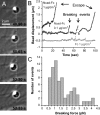
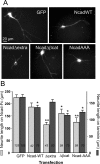
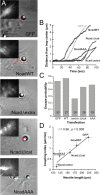
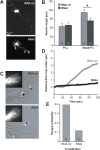
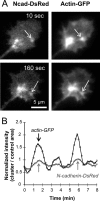
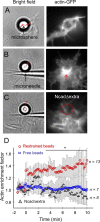

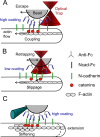
Similar articles
-
Regulation of N-cadherin dynamics at neuronal contacts by ligand binding and cytoskeletal coupling.Mol Biol Cell. 2006 Feb;17(2):862-75. doi: 10.1091/mbc.e05-04-0335. Epub 2005 Nov 30. Mol Biol Cell. 2006. PMID: 16319177 Free PMC article.
-
Two-tiered coupling between flowing actin and immobilized N-cadherin/catenin complexes in neuronal growth cones.Proc Natl Acad Sci U S A. 2015 Jun 2;112(22):6997-7002. doi: 10.1073/pnas.1423455112. Epub 2015 May 18. Proc Natl Acad Sci U S A. 2015. PMID: 26038554 Free PMC article.
-
Guidance of Axons by Local Coupling of Retrograde Flow to Point Contact Adhesions.J Neurosci. 2016 Feb 17;36(7):2267-82. doi: 10.1523/JNEUROSCI.2645-15.2016. J Neurosci. 2016. PMID: 26888936 Free PMC article.
-
Actin-based cytoskeleton in growth cone activity.Neurosci Res. 1993 Nov;18(2):91-102. doi: 10.1016/0168-0102(93)90012-f. Neurosci Res. 1993. PMID: 8127468 Review.
-
Actin-based growth cone motility and guidance.Mol Cell Neurosci. 2017 Oct;84:4-10. doi: 10.1016/j.mcn.2017.03.001. Epub 2017 Mar 6. Mol Cell Neurosci. 2017. PMID: 28268126 Free PMC article. Review.
Cited by
-
Rab33a mediates anterograde vesicular transport for membrane exocytosis and axon outgrowth.J Neurosci. 2012 Sep 12;32(37):12712-25. doi: 10.1523/JNEUROSCI.0989-12.2012. J Neurosci. 2012. PMID: 22972995 Free PMC article.
-
Molecular determinants for the strictly compartmentalized expression of kainate receptors in CA3 pyramidal cells.Nat Commun. 2016 Sep 27;7:12738. doi: 10.1038/ncomms12738. Nat Commun. 2016. PMID: 27669960 Free PMC article.
-
Axon Guidance and Collective Cell Migration by Substrate-Derived Attractants.Front Mol Neurosci. 2019 Jun 6;12:148. doi: 10.3389/fnmol.2019.00148. eCollection 2019. Front Mol Neurosci. 2019. PMID: 31244602 Free PMC article.
-
Patterned cortical tension mediated by N-cadherin controls cell geometric order in the Drosophila eye.Elife. 2017 May 24;6:e22796. doi: 10.7554/eLife.22796. Elife. 2017. PMID: 28537220 Free PMC article.
-
Asymmetric N-cadherin expression results in synapse dysfunction, synapse elimination, and axon retraction in cultured mouse neurons.PLoS One. 2013;8(1):e54105. doi: 10.1371/journal.pone.0054105. Epub 2013 Jan 31. PLoS One. 2013. PMID: 23382872 Free PMC article.
References
-
- Biederer T, Sara Y, Mozhayeva M, Atasoy D, Liu X, Kavalali ET, Sudhof TC. SynCAM, a synaptic adhesion molecule that drives synapse assembly. Science. 2002;297:1525–1531. - PubMed
-
- Boscher C, Mege RM. Cadherin-11 interacts with the FGF receptor and induces neurite outgrowth through associated downstream signalling. Cell Signal. 2008;20:1061–1072. - PubMed
-
- Bozdagi O, Shan W, Tanaka H, Benson DL, Huntley GW. Increasing numbers of synaptic puncta during late-phase LTP: N-cadherin is synthesized, recruited to synaptic sites, and required for potentiation. Neuron. 2000;28:245–259. - PubMed
Publication types
MeSH terms
Substances
LinkOut - more resources
Full Text Sources
Other Literature Sources
Research Materials
